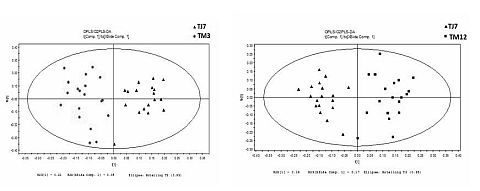Urinary Metabolomic Pattern Varies over Time and May Be Different in Patients Receiving Cyclosporine or Tacrolimus
EA4245, Université
François Rabelais, Tours, France
Meeting: 2013 American Transplant Congress
Abstract number: D1704
The tools currently available for clinical monitoring of kidney graft dysfunction are not optimal. Metabolomics is a post-genomic application for analysis of low-molecular weight compounds, allowing analysis of metabolites changes in biological samples, thus providing significantly more information than a limited set of biomarkers. Only a few metabolomic studies have been conducted in renal transplant patients.
We used 1H-Nuclear Magnetic Resonnance (NMR) and gas-chromatography/mass spectrometry (GC/MS) to profile urine samples of 47 kidney transplant patients. We analyzed whether the metabolic pattern differed according to the calcineurin inhibitor (CNI) used (tacrolimus-TAC or cyclosporine-CsA) and, for each CNI, if it varied over time during the first year following grafting (urine sampling at Day7, month (M)3 and M12). Metabolic profiles were compared according to graft function, i.e. estimated glomerular filtration rate (eGFR) at various times post-transplantation. Metabolic differences between groups were characterized by multivariate statistical analysis using principal component analysis (PCA) or projection to least squares discriminant analysis (PLS-DA). Metabolites which differed between groups were identified using reference NMR and GC/MS libraries.
We observed different metabolite patterns between TAC and CsA-treated patients, at each time-point. Metabolites that differentiate the drugs each others were hippurate, lactate and various sugars. Whatever the CNI used, the urinary metabolite profiles were shown to diverge between D7 and M3 or M12 but were not distinguishable between M3 and M12 (figure: results with TAC (left D7 vs M3; right D7 vs M12)).

Metabolite proliles were different according to renal function at each time-point.
This pilot study showed that NMR and GC/MS are appropriate tools for studying time-dependent changes in kidney metabolism in transplant patients. They can also discriminate patients treated with CsA or TAC. The metabolite pattern is linked to renal function, strengthening the need to conduct further metabolomic studies for biomarker discovery in transplantation.
To cite this abstract in AMA style:
Guellec CLe, Dieme B, Emond P, Blasco H, Lebranchu Y, Buchler M, Halimi J. Urinary Metabolomic Pattern Varies over Time and May Be Different in Patients Receiving Cyclosporine or Tacrolimus [abstract]. Am J Transplant. 2013; 13 (suppl 5). https://atcmeetingabstracts.com/abstract/urinary-metabolomic-pattern-varies-over-time-and-may-be-different-in-patients-receiving-cyclosporine-or-tacrolimus/. Accessed July 18, 2025.« Back to 2013 American Transplant Congress
